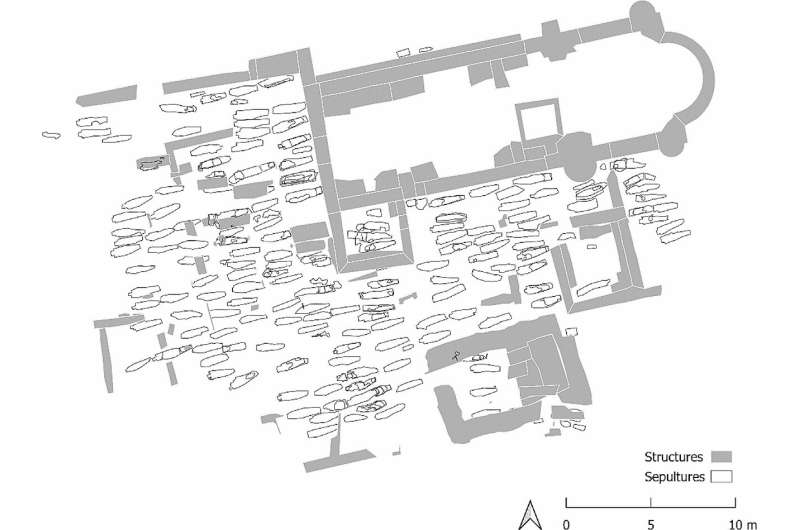"Isotope Analysis Uncovers Social and Religious Influences on Medieval French Diets"

August 1, 2024 feature
This article has been reviewed according to Science X's editorial process and policies. Editors have highlighted the following attributes while ensuring the content's credibility:
- fact-checked
- trusted source
- proofread
by Sandee Oster , Phys.org
Archaeologists working in the Languedoc region in southern France have used stable isotopes to reveal new insights into medieval dietary practices. The research, published in Archaeological and Anthropological Sciences by lead author Dr. Jane Holmstrom and colleagues, uncovered nuanced differences in diet among social classes based on the complex interplay of religion, social status, and diet.
Their findings are based on the analyses of skeletal remains from two cemeteries in southern France, one reserved for high-ranking church members from the elite Saint-Jean de Todon and one for the lower-class Saint-Victor-la-Coste. Both cemeteries date to between the 9th and 13th centuries AD and thus fall into a time in which great economic and social structural transformations were underway that could have influenced the diets of those interred in the cemetery.
During the end of the 8th century, various regions in Europe, including France, were affected by structural changes that affected the cultural, economic and social organization of society. About 200 years later, the Cluniac reforms brought about more change. These reforms were implemented after it was deemed that the church, its priests, nuns and members had strayed too far from the path envisioned by St. Benedict.
To remedy this, the church sought to restore greater uniformity and discipline among its members; this was achieved in a variety of ways, including through the implementation of dietary restrictions. These new regulations included forbidding the consumption of meat and setting limits to the amount of bread, wine and vegetables that could be consumed by church leaders.
These rules also applied to laypeople, though exceptions were made, such as laypeople being allowed to eat meat except on fasting days, during which only fish would be allowed. Furthermore, the very old, young and ill were exempt from these rules.
Using the above knowledge gleaned from historical records, the researchers hypothesized that elite individuals would likely have had a varied diet, including several plant products but also rich in fish and animal products (meat and dairy). The Cluniac monastic individuals would have had a mostly vegetarian diet with regular access to fish, while the lower-class would have had a primarily vegetarian diet, occasionally supplemented with fish or animal protein.
The data provided by the stable isotope analysis provided the researchers with a means to test these hypotheses. They found that within the elite cemetery of Saint-Jean de Todon, the individuals ate a diet heavy in oats, barley, rye, and wheat but also had regular access to animal protein, as hypothesized.
Interestingly, their findings also showed that females tended to consume fewer animal proteins than males. This is in line with the Benedictine fasting rules, which provided guidance on food distribution based on sex, age, and status. This may, in part, explain the different dietary signals observed between males and females in the cemetery.
Furthermore, it was found that despite some graves having markers while others had none, indicating different family status or social standing, individuals interred in both had similar diets. This implies that despite having potentially different social statuses in life, these individuals would still have eaten a diet very similar to one another.
Dr. Holmstrom stated, 'We were surprised that there was less of a distinction in diet between individuals with grave markers than those without in the St. Jean de Todon cemetery, as we had predicted that grave markers would indicate high social status.'
For Saint-Victor-la-Coste, diets were rather homogenous, consisting mostly of grains and vegetables, regardless of sex or other factors.
Interestingly, results for children from both cemeteries provided information on breastfeeding and weaning. More specifically, results indicate that children from Saint-Jean de Tondon between the ages of 2 and 3 or 4 years were either still being breastfed or were in the process of weaning. Meanwhile, children between the ages of 1 and 2 at Saint-Victor-la-Coste, almost two years younger than the children from Saint-Jean de Tondon, were already in the process of weaning. These data indicate that children of the elite would, on average, be breastfed for longer than children of the lower classes.
The study results provide interesting new insights into the dietary practices of medieval southern France, which were affected not only by socio-economic transformations but also by religion, age, and sex.




